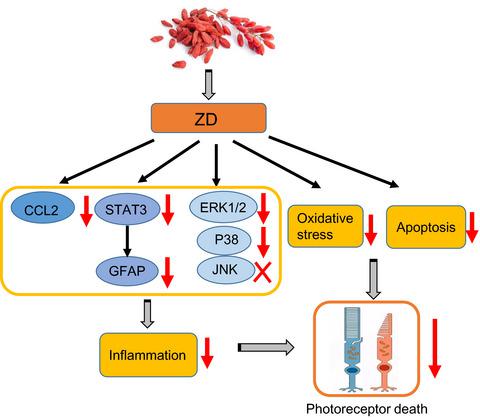当前位置:
X-MOL 学术
›
J. Neurochem.
›
论文详情
Our official English website, www.x-mol.net, welcomes your feedback! (Note: you will need to create a separate account there.)
Wolfberry-derived zeaxanthin dipalmitate delays retinal degeneration in a mouse model of retinitis pigmentosa through modulating STAT3, CCL2 and MAPK pathways
Journal of Neurochemistry ( IF 4.7 ) Pub Date : 2021-07-15 , DOI: 10.1111/jnc.15472 Feng Liu 1, 2 , Xiaobin Liu 1 , Yamin Zhou 3 , Yankun Yu 1, 4 , Ke Wang 1 , Zhengqun Zhou 5 , Hao Gao 5 , Kwok-Fai So 1, 6, 7 , Noga Vardi 8 , Ying Xu 1, 6, 7
Journal of Neurochemistry ( IF 4.7 ) Pub Date : 2021-07-15 , DOI: 10.1111/jnc.15472 Feng Liu 1, 2 , Xiaobin Liu 1 , Yamin Zhou 3 , Yankun Yu 1, 4 , Ke Wang 1 , Zhengqun Zhou 5 , Hao Gao 5 , Kwok-Fai So 1, 6, 7 , Noga Vardi 8 , Ying Xu 1, 6, 7
Affiliation

|
Retinitis pigmentosa (RP) is a group of inherited photoreceptor degeneration diseases that causes blindness without effective treatment. The pathogenesis of retinal degeneration involves mainly oxidative stress and inflammatory responses. Zeaxanthin dipalmitate (ZD), a wolfberry-derived carotenoid, has anti-inflammatory and anti-oxidative stress effects. Here we investigated whether these properties of ZD can delay the retinal degeneration in rd10 mice, a model of RP, and explored its underlying mechanism. One shot of ZD or control vehicle was intravitreally injected into rd10 mice on postnatal day 16 (P16). Retinal function and structure of rd10 mice were assessed at P25, when rods degenerate substantially, using a visual behavior test, multi-electrode-array recordings and immunostaining. Retinal pathogenic gene expression and regulation of signaling pathways by ZD were explored using transcriptome sequencing and western blotting. Our results showed that ZD treatment improved the visual behavior of rd10 mice and delayed the degeneration of retinal photoreceptors. It also improved the light responses of photoreceptors, bipolar cells and retinal ganglion cells. The expression of genes that are involved in inflammation, apoptosis and oxidative stress were up-regulated in rd10 mice, and were reduced by ZD. ZD further reduced the activation of two key factors, signal transducer and activator of transcription 3 and chemokine (C-C motif) ligand 2, down-regulated the expression of the inflammatory factor GFAP, and inhibited extracellular signal regulated protein kinases and P38, but not the JNK pathways. In conclusion, ZD delays the degeneration of the rd10 retina both morphologically and functionally. Its anti-inflammatory function is mediated primarily through the signal transducer and activator of transcription 3, chemokine (C-C motif) ligand 2 and MAPK pathways. Thus, ZD may serve as a potential clinical candidate to treat RP.
中文翻译:

枸杞来源的玉米黄质二棕榈酸酯通过调节 STAT3、CCL2 和 MAPK 通路延缓色素性视网膜炎小鼠模型的视网膜变性
视网膜色素变性 (RP) 是一组遗传性光感受器变性疾病,在没有有效治疗的情况下会导致失明。视网膜变性的发病机制主要涉及氧化应激和炎症反应。玉米黄质二棕榈酸酯 (ZD) 是一种枸杞衍生的类胡萝卜素,具有抗炎和抗氧化应激作用。在这里,我们研究了 ZD 的这些特性是否可以延迟 rd10 小鼠(RP 模型)的视网膜变性,并探索其潜在机制。在出生后第 16 天 (P16),将一剂 ZD 或对照载体玻璃体内注射到 rd10 小鼠中。rd10 小鼠的视网膜功能和结构在 P25 时进行评估,此时视杆细胞显着退化,使用视觉行为测试、多电极阵列记录和免疫染色。使用转录组测序和蛋白质印迹研究了视网膜致病基因表达和 ZD 对信号通路的调节。我们的结果表明,ZD 治疗改善了 rd10 小鼠的视觉行为并延迟了视网膜光感受器的退化。它还改善了光感受器、双极细胞和视网膜神经节细胞的光反应。与炎症、细胞凋亡和氧化应激有关的基因的表达在 rd10 小鼠中上调,并被 ZD 降低。ZD 进一步降低了两个关键因子的激活,信号转导和转录激活因子 3 和趋化因子(CC 基序)配体 2,下调炎症因子 GFAP 的表达,并抑制细胞外信号调节蛋白激酶和 P38,但不是JNK 途径。综上所述,ZD 在形态和功能上延迟了 rd10 视网膜的退化。其抗炎功能主要通过信号转导和转录激活因子 3、趋化因子(CC 基序)配体 2 和 MAPK 通路介导。因此,ZD 可作为治疗 RP 的潜在临床候选药物。
更新日期:2021-08-26
中文翻译:

枸杞来源的玉米黄质二棕榈酸酯通过调节 STAT3、CCL2 和 MAPK 通路延缓色素性视网膜炎小鼠模型的视网膜变性
视网膜色素变性 (RP) 是一组遗传性光感受器变性疾病,在没有有效治疗的情况下会导致失明。视网膜变性的发病机制主要涉及氧化应激和炎症反应。玉米黄质二棕榈酸酯 (ZD) 是一种枸杞衍生的类胡萝卜素,具有抗炎和抗氧化应激作用。在这里,我们研究了 ZD 的这些特性是否可以延迟 rd10 小鼠(RP 模型)的视网膜变性,并探索其潜在机制。在出生后第 16 天 (P16),将一剂 ZD 或对照载体玻璃体内注射到 rd10 小鼠中。rd10 小鼠的视网膜功能和结构在 P25 时进行评估,此时视杆细胞显着退化,使用视觉行为测试、多电极阵列记录和免疫染色。使用转录组测序和蛋白质印迹研究了视网膜致病基因表达和 ZD 对信号通路的调节。我们的结果表明,ZD 治疗改善了 rd10 小鼠的视觉行为并延迟了视网膜光感受器的退化。它还改善了光感受器、双极细胞和视网膜神经节细胞的光反应。与炎症、细胞凋亡和氧化应激有关的基因的表达在 rd10 小鼠中上调,并被 ZD 降低。ZD 进一步降低了两个关键因子的激活,信号转导和转录激活因子 3 和趋化因子(CC 基序)配体 2,下调炎症因子 GFAP 的表达,并抑制细胞外信号调节蛋白激酶和 P38,但不是JNK 途径。综上所述,ZD 在形态和功能上延迟了 rd10 视网膜的退化。其抗炎功能主要通过信号转导和转录激活因子 3、趋化因子(CC 基序)配体 2 和 MAPK 通路介导。因此,ZD 可作为治疗 RP 的潜在临床候选药物。



























 京公网安备 11010802027423号
京公网安备 11010802027423号